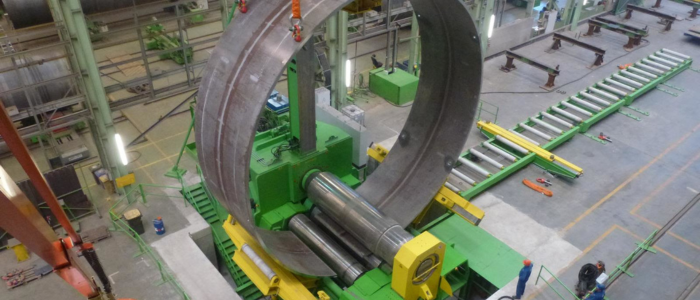Case Study – Never Suffer From Buying The Wrong Plate Roll Machine

NEVER SUFFER FROM BUYING THE WRONG PLATE ROLL MACHINE
We all look at developing our business to improve our competitive position and be more efficient. It’s fair to think about all of our assets when we do this as well as our people, guarding ourselves against making the incorrect
choice.
Recently, a fabricator won a plate-rolling project that required the business to invest in a larger plate-rolling machine to increase their capacity. They had forecast the purchase of an ex stock European linear guide plate roll machine from Specialist Machinery Sales (SMS). When the contract was awarded the linear slide machine was no longer in stock and available. Not wanting to turn down the rolling project, the business purchased a swing slide machine that was in stock to full fill the contract. They were also pleased to purchase a lower cost machine than they originally specified when tendering the project. It turned out to cost them more than the difference in the two machines for the three significant reasons.
The 40-year business had never previously rolled plate with a swing slide design machine. They had not allowed for the additional effort and expense that is required when rolling a plate on a swing slide machine. They found the machine produced a larger flat end. Therefore, the price quoted per shell could not be achieved due to the re-work required to correct the flat
end. Deliveries ran late and attracted penalties to the project.
Another challenge that could not be overcome was the fabricator assumed that all plate rolling manufactures used the same material elasticity or yield point. What they discovered after it was too late was the plate rolling machine tool builder had used a different yield point to the plate-rolling machine that was originally specified. This prevented the machine from rolling the thicker plates and tighter diameters so the machine specification did not meet the performance outcomes required.
The top roll diameter (TRD) is used to assist customers in comparing capacities of machines and in this instance, it was too small. The TRD is dependent on the maximum capacity of the machine and provides the exact information on the machines real capacity and the quality that can be expected. The business is now left with a machine that did not meet this or future projects performance expectations. The business will not serve the gap in the market that the machine was expected to supply.
HOW DO YOU BUY THE WRONG NEW OR USED MACHINE?
When we bring assets into our business we do so because they can bring value. If we don’t understand “precisely” how that value is going to be realised, are we making a good choice? The risk of getting it wrong can have significant long-term implications for your business and the bottom line. Incorrect utilisation of resources including labour, cash flow, floor space, power and limitations on the type of work a business can bid for and win. By not asking the right questions from the subject matter expert about the specification, your business’s expected performance outcomes may not be realised. That is how easy it is to make a poor choice.
WHAT HAPPENS WHEN YOU BUY THE WRONG MACHINE?
When we accept that our current assets are not performing (by capacity, availability or reliability) we know we need to either supplement or replace them.
By not understanding the gap that has driven the need to look elsewhere we can often find comfort in familiarly, prior knowledge and peer relationships. While this can be a good source of shared experience, very few will tell us what happens next. Lost contracts, damaged reputation, reduced capabilities, poorly engaged workforce are all amongst the experiences that have been recounted for too many clients considering making change. A gap analysis can identify the performance shortfall that highlights the deficiency in business capabilities.
WHAT HAPPENS WHEN YOU BUY THE CORRECT MACHINE?
By partnering with a machine tool supplier with the knowledge and expertise to match your performance outcomes to bid and win work. Information will be required regarding: capacity expectations, revenue and SWOT profiles, value gap analysis, supply chain management, complementary processes, material handling, training and support.
Clients of Specialist Machinery Sales have reported the value of engaging and gaining our support and participation in the design process to create the specification that will maximise your value and ROI. Clients can forecast a more competitive, efficient and productive product offering when performance and quality concerns are addressed.
Learn More
Contact Specialist Machinery Sales today to discuss a superior machinery strategy for your business.
